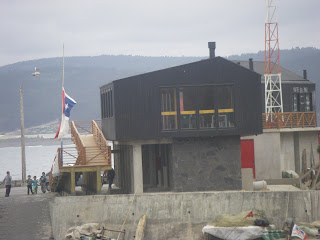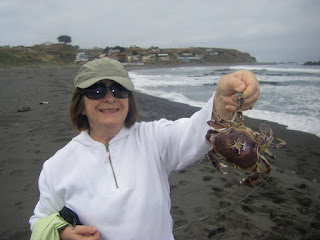“The New Coastal Panorama of Maule", reads the title of the article in El Mercurio’s
Vivienda Y Decoración magazine section that greeted us the day we arrived in Chile. Beautiful pictures of architecturally interesting buildings situated right at water’s edge in the small fishing villages of Boyeruca, Duao, Pellines, Pelluhue, Curanipe and Loanco proudly provided visual testimony of the near completion of this
Ruta del Mar project. This is a notable example of one group of Chileans (Grupo Antofagasta Minerals) helping their artisan fishing brothers and sisters recover from the tsunami of February 27, 2010.

The idea was to create a series of structures in the fishing villages that would combine modern and traditional design while providing services to attract tourists and space for the artisan fishermen to store their fishing equipment and carry out the chores of cleaning and marketing their catch. I must admit to having been skeptical when this program was announced over a year ago. It just seemed too innovative, even transformational for these poorest of Chilean villages. So when I saw the pictures in this flashy, mostly “good news” magazine, all so very attractive, I felt a surge of optimism. But upon closer scrutiny of the pictures and the story, I got a different feeling, that things were not yet going as expected.
So, just a week after arriving in Chile, we set off to ill-fated Maule again to observe the earthquake/tsunami recovery process first hand. This time Ximena went along, to visit Ximena’s sister Veronica and her husband Joaquin at their home that overlooks the Pacific Ocean, with El Faro Carranza in view to the north, and my adopted fishing village of Loanco to the south. The Pan American highway, as it heads south from Santiago, cuts straight through beautiful vineyards and orchards, through the central valley towns of Rancagua, San Fernando, Curico, and then Talca. The Rio Claro flows from the Andes to the Pacific Ocean, crossing the highway just south of Talca. The tall two-lane bridge over the Rio Claro became an icon when it was totally destroyed in the 2010 earthquake. For the past two years, the rebuilding of this bridge has had the effect of a tourniquet tied tightly around this north-south transportation artery that runs the entire length of Chile, producing traffic backups and long delays. We passed alongside the collapsed bridge, on a temporary structure, recalling the enormity of the damage caused to Chile’s infrastructure in the 2010 earthquake. But, this is the last of the major road and bridge repairs required along the Pan American highway. Traffic is moving much more smoothly now, and the reconstruction of this 125 meter-long bridge is scheduled to be completed by the end of 2012. They claim this one is antiseismic. Let’s hope so.
Just past the Rio Claro we turned west off the highway and took the road that winds through first agriculture and then forested land as it crosses the coastal range and decends into Constitucion, one of the towns most affected by the earthquake and tsunami. Constitucion is still cleaning up the rubble and trying to rebuild. The Celco pulp mill, initially closed due to water damage from the tsunami, is clearly working, belching characteristically ugly, odorous smoke into the clear coastal air, but people are back to work. Rebuilding Constitution is surely one of the greatest challenges the Chileans face. Terribly convoluted issues of sorting out land ownership, approval and application of new building standards, establishing procedures to provide subsidized funding for homes and businesses, all take seemingly endless weeks and months to work out. The area along the river, totally destroyed two years ago is still awaiting resolution of these issues, showing little progress to date. If I were to suggest it would take 8 to 10 years to get Constitucion back on its feet I could be accused of being overly optimistic.
In the face of this challenge, though, there is one encouraging story to be told: the rebirth of “
Cabanas Playa El Cable”. Three kilometers down the narrow road that runs south along the coast from the beach area of Constitucion to a fishing pier originally built to service the Celco mill, is where Guillermo and Javiera lost their home and their tourist business (cabins and restaurant) to the tsunami. Their story has been told in part in earlier postings on this blog (See April 26, 2011 posting ). We decided to pay them a visit, before going on to “El Faro”, to see how they were progressing with their rebuilding, and if feasible, arrange to stay overnight the next Sunday on our way back to Santiago.


When we drove down to the parking area, Guillermo and Javiera dropped what they were doing and rushed to great us. Proudly pointing out the now 20 cabins finished and ready for occupancy, the pool area already being used, and the attractive two-story restaurant, they assured us we would have a cabin to stay in Sunday evening, the restaurant would be open for dinner, and they would tell us all about how they were doing.
So, we moved on down the coast, almost jubilant from having seen Guillermo and Javiera so excited about the progress they have made. We bought several
merluza filets at a roadside stand and drove to Veronica and Joaquin’s home, called “
El Faro”. We unloaded our bags from the car, and immediately joined Marira and George (Veronica and Joaquin’s daughter and Scotch/Chilean husband), who had prepared slices of mild Chanco cheese, spicy salame, and pisco sours for the “El Faro happy Hour”. We sat on the porch and marveled at how pacific the Pacific Ocean was, not a normal condition, and how low the water was around the long rib of rocks protruding into the ocean from the shore near where the Carranza lighthouse is. This group of rocks is inhabited by hundreds of sea lions (called “
lobos” locally), and this afternoon, without the normal high winds and rough surf, the lions produced a din so loud (and an occasional whiff of guano so strong) they seemed to be right next to us.
With the dust from our journey from Santiago finally washed from our throats, we drove to the small fishing village of Loanco, to meet Veronica and Joaquin for dinner at another “adopted” place,
Restaurante Las Rocas, the rebuilt seaside restaurant owned by Maria and Dago (also the subject of earlier postings in this blog).

As we drove down the hill into town, a weird feeling hit me. I knew why immediately, but I didn’t say anything. I was trying to rationalize what I was seeing, but to no avail. There were no boats in Loanco!

No boats, no tractor to pull them out of the water, no flocks of seagulls picking over piles of discarded fish, no dogs running around, no refrigerated trucks loading fish, and most noteworthy..no fishermen. I was shocked to say the least. But not too shocked to have a nice dinner of abalone (“
locos”)fried
merluza and
corvina, and a generous amount of Misiones de Rengo sauvignon blanc

Incredible as it may sound, the artisan fishermen of Loanco, with their new boats and motors made possible by donations received after the tsunami destroyed everything they had, have decided to move their boats out of Loanco, 7 kilometers up the coast, to a spot they claim is more appropriate for launching and landing their boats. No matter, apparently, that the new
Ruta del Mar installation has now been finished and is ready to be put into operation. So, Loanco's shores are desolate, and the new restaurant, equipment storage and fish processing facility stands vacant. Unbelievable, but true.

The next day, Ximena and I checked out the new
Ruta del Mar facility at Pellines, just a few kilometers up the road from Loanco, also featured in the El Mercurio V&D magazine. .

Here also, the new facility is finished, but closed. Reason? Paperwork for operating the restaurant has not been finalized. So, in the middle of summer, the tourist season, this establishment also just sits and waits for someone to do something. The fate of these much acclaimed facilites in Loanco and Pellines remains uncertain, but while an optimist would suggest everything will eventually work out, I am of the mind that a lot of thought went into the design of the "Ruta del Mar" facilities, but far too little attention to the business and implementation side of the project. It seems like these facilities were just turned over to a group of fishermen and their families with little concern for who would be in charge and how they would operate the business. We



returned to Constitucion to spend the night at Guillermo and Javiera's lovely seaside cabins. Over cold pisco sours,
pastel de jaiva,(crabmeat pie) grilled
reineta, and some Concha y Toro Sauvinon blanc Reserva, we talked about how they were able to rebuild their business. It seems that their location so close to the sea prohibits insurance that is required for normal business bank loans, so they have had to scratch for capital. But little by little, they are making it. The night we were there the cabins were mostly occupied. They want to hook into tourism agencies with US and European clients, but so far are benefiting mostly from word of mouth to market their place. Soon they will build their new home up on a bluff above the cabins alongside the road. The old one was wiped out by the tsunami, and the new restaurant has been built on that site. It's not easy for Guillermo and Javiera, and it is not clear that they will be able to capture a reliable flow of guests to continue to improve and expand their business, but the energy and persistence with which they are going forward, with very little help from official relief programs, is encouraging.
So there you have it; three post-tsunami projects:
Restaurante Las Rocas,
Cabanas Playa El Cable and
Ruta del Mar. Two moving ahead through the perseverance and hard work of committed entrepreneurs, Maria and Dago, Guillermo and Javiera, and the other stalled due in part to uncertain management responsibilities and capabilities, and ineffective involvement of local public sector agencies and bureaucratic lethargy. After an event like the Chilean tsunami, it is not easy to get businesses back operating and people back to work. But it is essential. Small businesses are the lifeblood of towns like Loanco, Pellines, Chanco, and Constitucion. To get them going again requires access to capital and temporary relief from taxes on small business. Support from government to decrease regulatory hurdles helps, but as these three cases prove, finding your own source of capital and simply moving ahead with the rebuilding process without waiting for public or private assistance seems to work best. In fact that is what Guillermo says he suggests to his small business friends.."just get going! Don't wait for help. If it comes, all the better. But don't wait for it."

Posted on February 5, 2012, in Santiago, Chile













































